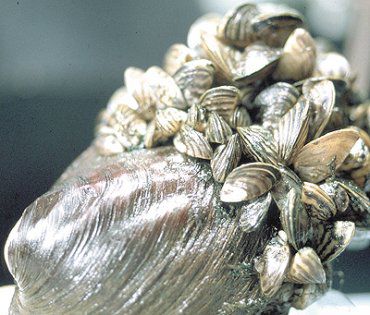A core response team has been established to deal with the quagga and zebra mussel infestation which is now in Utah. Two bodies of water in Utah, Electric Lake and Red Fleet reservoirs, have been confirmed as infested with the mussels.
Red Fleet Reservoir near Vernal is infested with the quagga mussel, and Electric Lake in Huntington Canyon is confirmed infested with the zebra mussel. These mussels are not native to North America and are considered aquatic invasive species.
The San Rafael area core response team met recently in the Emery County building to discuss the draft rapid response plan it is now considering. Daniel Keller from the Utah Division of Wildlife Resources reviewed the draft and took comments for revisions.
“This response plan is based on one water sample taken in the summer of 2008,” said Keller. “These mussels pose a serious problem and we are taking a very proactive stance with the confirmation of their infestation in Utah waters.” He noted these mussels have done billions of dollars worth of damage in other parts of the country by clogging water pipes and degrading water quality.
Keller went on to explain the necessary tests to confirm an infestation. The protocol is: visual observation of the mussel or veligers (larval stage of the mussel). Following this confirmation under the microscope, two DNA tests are done on the sample. The first is the Wood/Kelly ribosomal DNA test, and the second is the DeLeon/Russell mitochondrial DNA test. If a water sample tests positive in all three of these tests, the body of water is considered infested. Other waters in the state have tested inconclusive for one or more test, but not all three. These waters are considered inconclusive, or watch waters. Waters in the same drainage as infested waters are also considered watch waters.
Dan Richards, supervisor of the Millsite, Huntington North, and Scofield state parks has developed a monitoring system for those three waters. “We have trained our permanent staff and will train our seasonal workers. We have a form each boater must fill out prior to launching their boat. The questions deal with where their boat has been during the past 30 days. If they have been in an infested water, their boat must be decontaminated before it can launch,” said Richards. “It is very important to make everyone aware of this situation.” He added that most boaters during the past season were very open and receptive to this process.
“They all know that if a water is infested, the DWR has the right to close that water to all activities. We don’t want to have waters closed, that is a last resort, but it is extremely important to confine the infestation,” said Richards.
Richards outlined the critical control points he and his staff will inspect regularly in each body of water. They will inspect boat docks, shorelines as the water fluctuates, and any other cement or other item on which the mussels can attach. He has also created a form for tracking the monitoring process.
Cody Allred of PacifiCorp, explained the plan of action for inspection at the power plants. “We are implementing a good, strong monitoring system. We need to learn more about these mussels, and have been in contact with power plants in the East which have been dealing with them for some time. We have a rigourous inspection plan and will create a checklists to document the process. We will inspect and monitor Huntington and Hunter plants and holding ponds, along with all PacifiCorp’s facilities,” said Allred.
Keller explained the irrigation companies in the area are very concerned about the mussel infestation, as well as the water conservancy districts. “Now that infestation has been confirmed, the questionnaires will be more intensive, and the visual inspections of boats and decontaminations will be more rigourous,” said Keller. “Many agencies in the area have partnered together for this process. We need to focus on education of all water users, not only boaters, but float tubes and others. Everyone who uses the waters need to know the decontamination techniques. Law enforcement will be very strict with those who certify to the condition of their boat. One boater who blew past the decontamination station at Lake Powell was fined $4,000. Boaters who have been in watch waters will be asked to voluntarily wash their boats prior to launch,” said Keller.
Keller explained the concerns from the San Rafael response team have been combined into eight categories. They are containment, affected systems and resources, control, funding, research, monitoring protocol, communications, and availability of technical resources.
Keller has also set up the protocols for the rapid response strategy. They are: immediately verify a reported detection; immediately notify all relevant natural resource managers; immediately begin surveys and define the extent of infestation; set up an appropriate command structure to guide the response team; establish internal and external communications systems; organize available resources; prevent further spread; apply available, relevant eradication and controls; institute long term monitoring; and evaluate response effectiveness. In the draft response plan, each of these steps has contact numbers and protocol to be followed in the event of a detection of the mussels or veligers.
Keller informed the core response team the DWR will be conducting more intensive samplings during the upcoming season.
A plan for the mussels

"The zebra mussels are a cause of concern for area water users."
